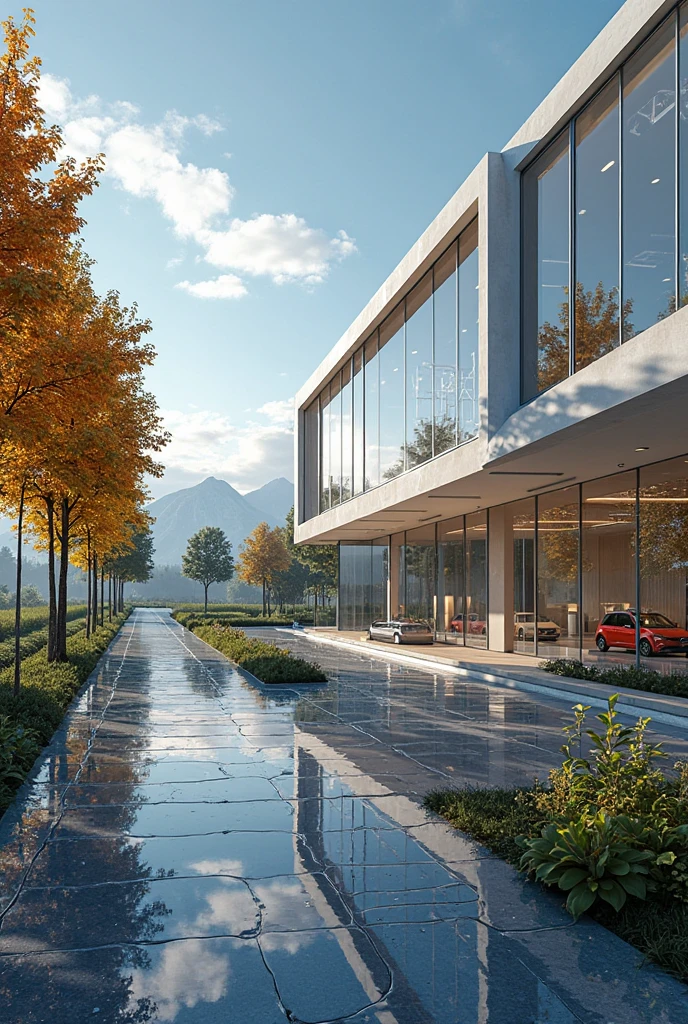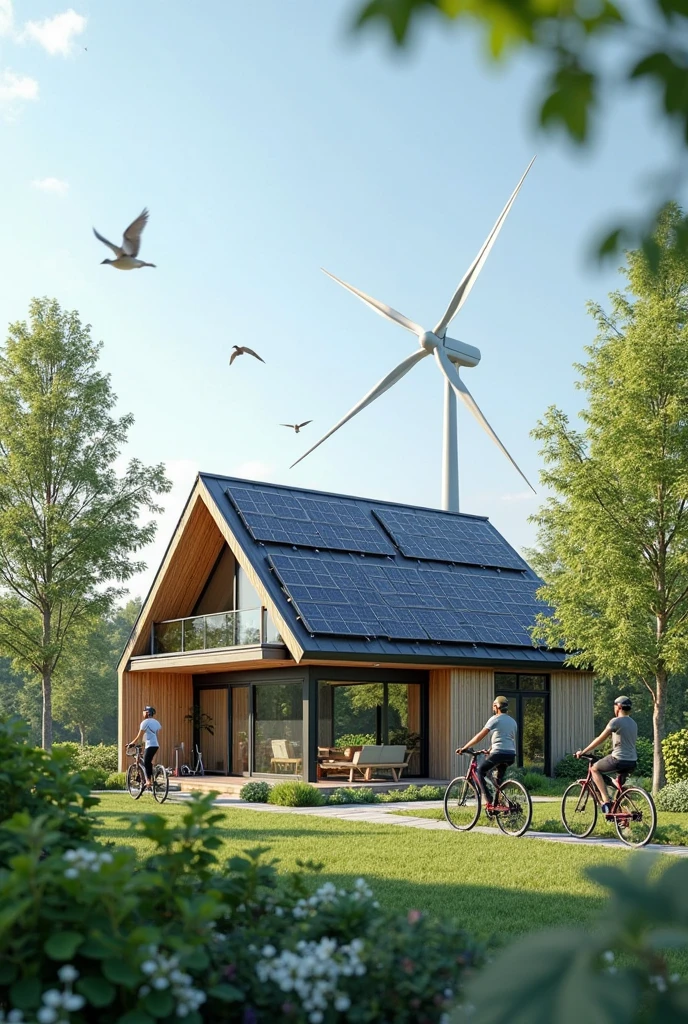Introduction
Last month, my neighbor Sarah installedh solar panels on her roof, a smart water monitoring system in her bathroom, and energy-efficient appliances throughout her kitchen. When I visited her recently, she proudly showed me an app on her phone that tracked her household’s carbon footprint reduction – an impressive 40% decrease in just three months. “It’s not just about saving money anymore,” she explained. “It’s about making choices today that ensure my grandchildren have a habitable planet tomorrow.”
Sarah’s story is increasingly common as more people embrace eco-friendly technologies for sustainable living. These innovations are revolutionizing how we interact with our homes, consume resources, and think about our environmental impact. From renewable energy systems to smart water conservation tools, these technologies are no longer futuristic concepts but practical solutions that help ordinary people live more sustainably while often improving their quality of life.
The acceleration of eco-friendly technologies for sustainable living has been remarkable in recent years, driven by increasing environmental awareness, technological advancements, and economic incentives. As we navigate the challenges of climate change, resource depletion, and environmental degradation, these innovations offer tangible pathways to a more sustainable future.
Industry Background and Market Trends
The Evolution of Sustainable Technology
The journey toward today’s eco-friendly technologies began decades ago with basic energy conservation measures and early solar power experiments. The environmental movement of the 1970s sparked interest in alternative energy sources, but technologies were expensive and inefficient. The 1990s and early 2000s saw gradual improvements, with the introduction of Energy Star appliances and more accessible solar options.
Today’s landscape is dramatically different. The sustainability market has expanded enormously, valued at $24.40 billion in 2025 and projected to reach $41.64 billion by 2030, according to Mordor Intelligence, with a robust compound annual growth rate (CAGR) of 19.5%. This growth is fueled by increasing regulatory alignment, corporate sustainability commitments, and consumer demand for environmentally responsible products.
Current Market Dynamics
Investment in green technology reached record levels in 2024, with global funding hitting $2.1 trillion according to BloombergNEF’s Energy Transition Investment Trends report. This significant investment is distributed across several key sectors:
- Electrified Transport: The largest category with $757 billion invested in 2024, encompassing electric vehicles, charging infrastructure, and other clean transportation solutions.
- Renewable Energy: Close behind with $728 billion invested in solar, wind, biofuels, and other clean energy technologies.
- Power Grids: Receiving $390 billion to upgrade and modernize electricity transmission and distribution systems.
- Emerging Technologies: Including hydrogen, carbon capture, and other innovative solutions, which attracted $155 billion.
The sustainability transformation solutions market specifically is calculated at $2.10 billion in 2025 and is forecasted to reach around $7.13 billion by 2034, growing at a CAGR of 22.60%. This growth is primarily driven by corporate sustainability initiatives, regulatory pressures, and increasing consumer preference for eco-friendly products and services.
Key Innovations and Concepts
Advanced Solar Technology

Solar energy has undergone a remarkable transformation in recent years, becoming more efficient, affordable, and versatile. Modern photovoltaic systems can now be integrated seamlessly into building materials, including:
- Solar Roof Tiles: Companies like Tesla and SunRoof offer solar shingles that look indistinguishable from traditional roofing materials while generating clean electricity.
- Transparent Solar Panels: Innovative companies are developing transparent solar cells that can be integrated into windows, allowing buildings to generate energy without sacrificing natural light.
- Perovskite Solar Cells: This next-generation solar technology offers higher efficiency and potentially lower manufacturing costs than traditional silicon panels.
The adoption of residential solar is accelerating, with many homeowners combining solar installations with battery storage systems to increase energy independence and resilience during power outages.
Smart Home Energy Management
Intelligent energy management systems represent one of the most accessible eco-friendly technologies for sustainable living. These systems optimize home energy use through:
- AI-Powered Climate Control: Smart thermostats like those from Nest (Google) and ecobee learn household patterns and adjust temperature settings automatically to reduce energy consumption while maintaining comfort.
- Energy Monitoring Systems: Devices from companies like Sense and Emporia provide real-time insights into home energy usage, helping identify energy-wasting appliances and behaviors.
- Automated Lighting Solutions: Advanced lighting systems adjust brightness based on natural light availability and occupancy, significantly reducing electricity consumption.
These systems are increasingly interconnected, allowing for comprehensive energy management through smartphone apps and voice assistants. By 2025, homeowners could save up to $1,300 annually on electricity bills through smart home technologies, while reducing greenhouse gas emissions by approximately 21%.
Water Conservation Technologies
Water scarcity is becoming a pressing global issue, driving innovation in water conservation technologies:
- Smart Irrigation Systems: Companies like Rachio and Netro offer weather-responsive irrigation controllers that adjust watering schedules based on local weather forecasts, soil moisture levels, and plant needs.
- Greywater Recycling Systems: These systems capture and treat water from showers, bathroom sinks, and washing machines for reuse in toilet flushing and garden irrigation.
- Water Monitoring Devices: Products like Flume and Phyn detect leaks, track water usage, and help households reduce water waste through real-time feedback.
- Low-Flow Fixtures: Advanced aerating technologies in showerheads and faucets maintain water pressure while reducing consumption by up to 50%.
These water-saving technologies are becoming standard features in sustainable home designs, addressing both environmental concerns and increasing water costs.
Sustainable Building Materials
The construction industry is embracing eco-friendly materials that reduce environmental impact:
- Mass Timber: Engineered wood products like cross-laminated timber (CLT) offer a renewable alternative to steel and concrete, with lower embodied carbon and impressive structural properties.
- Recycled and Upcycled Materials: Innovative products made from recycled plastics, glass, and other waste materials are finding applications in insulation, countertops, and building facades.
- Bio-Based Materials: Hemp-based building materials, mycelium insulation, and other biological materials offer sustainable alternatives to petroleum-based products.
These materials not only reduce the environmental footprint of construction but often create healthier indoor environments with fewer toxic chemicals and better air quality.
Real-Life Applications
Impact on Everyday Users
Eco-friendly technologies are transforming daily life for average consumers in numerous ways:
Home Energy Independence
Solar panels combined with home battery systems like the Tesla Powerwall are freeing homeowners from complete dependence on the grid. Sarah, from our introduction, reduced her monthly utility bills by 65% after installing a 7kW solar system with battery backup. Beyond financial savings, she values the energy security during power outages and the satisfaction of powering her home with clean energy.
Smart Water Management
Water conservation technologies are helping households dramatically reduce water consumption. The Johnson family in water-stressed Phoenix installed a smart home water management system that detected a toilet leak within 24 hours of installation, potentially saving thousands of gallons annually. Their system also optimized their irrigation schedule, reducing outdoor water use by 30% while maintaining their garden’s health.
Healthy Indoor Environments
Sustainable building materials and ventilation systems are creating healthier homes. The Williams family renovated their 1970s home using non-toxic, sustainable materials and an energy recovery ventilation system. Their daughter’s asthma symptoms improved significantly after the renovation, highlighting the health benefits of eco-friendly building approaches.
Business Transformation
Companies across industries are leveraging sustainable technologies to reduce costs and meet environmental goals:
Commercial Building Efficiency
Office buildings equipped with comprehensive energy management systems are seeing dramatic reductions in operating costs. One mid-sized accounting firm in Chicago reduced its energy consumption by 42% after installing an integrated system of smart lighting, HVAC optimization, and automated blinds that respond to sunlight and temperature conditions.
Sustainable Manufacturing
Manufacturing facilities are implementing closed-loop water systems, renewable energy, and smart resource management. A textile manufacturer in North Carolina reduced water consumption by 60% and energy use by 35% through technology investments, while simultaneously improving product quality and worker satisfaction.
Retail Innovation
Retailers are using eco-friendly technologies to improve operations and appeal to environmentally conscious consumers. Whole Foods Market has implemented advanced refrigeration systems that reduce energy consumption and use natural refrigerants with lower global warming potential, cutting their carbon footprint while maintaining food quality.
Community and Urban Solutions
Sustainable technologies are scaling beyond individual homes to transform entire communities:
Smart Neighborhoods
Planned communities like Whisper Valley in Austin, Texas, incorporate geothermal heating and cooling, solar panels, and smart home technology as standard features in all homes. These integrated approaches achieve greater efficiencies than piecemeal solutions.
Urban Water Management
Cities like Los Angeles are implementing smart water grids that detect leaks, monitor quality, and optimize distribution. These systems have reduced water losses by up to 25% in some districts while ensuring safer drinking water.
Community Renewable Energy
Solar gardens and community wind projects allow residents without suitable properties for individual installations to invest in and benefit from renewable energy. These shared systems often achieve better economies of scale than individual home installations.
Future Outlook
Emerging Trends for 2025-2030

The next five years will likely see several transformative developments in eco-friendly technologies:
- AI-Optimized Resource Management: Artificial intelligence will increasingly coordinate home systems to maximize efficiency, predicting needs and automatically adjusting resource use based on occupancy patterns, weather, and grid conditions.
- Vehicle-to-Home Integration: Electric vehicles will become integral parts of home energy systems, providing backup power during outages and storing excess solar production.
- Affordable Energy Storage: Battery costs are projected to continue falling, making home energy storage economically attractive for more households and enabling greater renewable energy integration.
- Biophilic Technology: Systems that integrate natural processes with technology, such as living walls with built-in water filtration, will combine aesthetic benefits with environmental functions.
- Circular Economy Solutions: Technologies that enable material reuse and recycling will become more mainstream, reducing waste and resource consumption.
The sustainability market is expected to grow substantially, with IoT-based solutions projected to lead with a 40.67% market share, while AI and analytics are forecast to record a 20.65% CAGR through 2030.
Sustainability and Resource Efficiency
Future eco-friendly technologies will increasingly focus on maximizing resource efficiency:
- Ultra-Efficient Appliances: Next-generation appliances will reduce energy and water use far beyond current standards, with technologies like heat pump dryers becoming mainstream.
- Precision Resource Management: Systems will manage resources with unprecedented precision, applying exactly what’s needed when needed, whether it’s water for plants or electricity for specific tasks.
- Integrated Renewable Systems: Solar, wind, and other renewable sources will work together more seamlessly, complementing each other’s generation patterns for more reliable clean energy.
These advancements will help households and communities reduce their ecological footprint while maintaining or improving quality of life.
Challenges and Limitations
Addressing Accessibility and Affordability
While eco-friendly technologies offer tremendous benefits, they aren’t equally available to all:
- Upfront Cost Barriers: Many sustainable technologies require significant initial investment, placing them out of reach for lower-income households. Solar systems, though increasingly affordable, still represent a major expense for many families.
- Split Incentives: In rental properties, landlords often bear the costs of improvements while tenants receive the utility savings, creating reluctance to invest in efficient technologies.
- Geographic Disparities: Rural communities often have less access to newer technologies and the expertise needed to implement and maintain them.
Potential solutions include:
- Expanded financing options like Property Assessed Clean Energy (PACE) programs
- Subsidies and tax incentives targeted at lower-income households
- Community-based approaches that achieve economies of scale
- Rental property efficiency standards that address split incentives
Technical and Integration Challenges
Even as technologies improve, several technical challenges remain:
- Interoperability Issues: Different smart home systems often don’t communicate effectively, creating “islands” of automation rather than truly integrated solutions.
- Grid Integration: As more homes generate their own power, electrical grids must evolve to accommodate bidirectional energy flows and maintain stability.
- Complexity and Maintenance: More sophisticated home systems can be difficult for average users to understand and maintain properly.
- Cybersecurity Concerns: Connected home systems can create new vulnerabilities if not properly secured.
Industry efforts to address these challenges include:
- Development of universal standards like Matter for smart home devices
- Grid modernization initiatives by utilities
- Simplified user interfaces and automated maintenance alerts
- Enhanced security protocols and regular updates
Conclusion
Eco-friendly technologies for sustainable living represent one of our most promising paths toward addressing pressing environmental challenges while enhancing quality of life. From generating clean energy through advanced solar systems to conserving water with smart monitoring tools, these innovations enable individuals, businesses, and communities to reduce their environmental impact without sacrificing comfort or convenience.
The growth trajectory of these technologies is impressive, with multibillion-dollar markets expanding at double-digit rates annually. This economic momentum, combined with increasing environmental awareness and supportive policies, suggests that sustainable technologies will become increasingly mainstream in the coming years.
As we look to the future, the integration and optimization of these systems will likely yield even greater benefits, creating homes and communities that are not only more environmentally responsible but also healthier, more comfortable, and more resilient. The technologies discussed in this article provide concrete tools for addressing climate change, resource depletion, and pollution at the individual and community levels.
While challenges of affordability, accessibility, and technical integration remain, the overall direction is clear: eco-friendly technologies for sustainable living are transforming how we interact with our environments and offering tangible solutions to some of our most pressing global challenges.
Subscribe for more insights into sustainable living technologies, or share your experiences with eco-friendly home innovations in the comments below.
Frequently Asked Questions
What are the most cost-effective eco-friendly technologies for sustainable living that homeowners can implement today?
Smart thermostats and energy monitoring systems offer the best return on investment for most homeowners. With costs typically between $100-300, these devices can reduce energy bills by 10-15% while requiring minimal installation effort. LED lighting is another high-value option, using 75% less energy than incandescent bulbs with a much longer lifespan. For water conservation, low-flow fixtures and smart irrigation controllers provide significant savings with modest upfront costs. While solar panels have a higher initial investment, their long-term financial benefits make them increasingly cost-effective, especially in sunny regions and areas with high electricity rates. Many eco-friendly technologies for sustainable living also qualify for tax incentives and rebates, further improving their economic value.
How do eco-friendly technologies for sustainable living impact a home’s resale value?
Homes equipped with eco-friendly technologies typically command premium prices in today’s real estate market. According to recent studies, homes with solar panels sell for approximately 4.1% more than comparable properties without solar installations. Energy-efficient features like smart climate control systems, high-performance windows, and modern insulation can increase home values by 2-5% while making properties more attractive to environmentally conscious buyers. Beyond price, homes with sustainable technologies often sell faster, spending an average of 10 fewer days on the market. As environmental awareness continues to grow, the value premium for eco-friendly homes is expected to increase, making these technologies not just environmentally responsible choices but sound financial investments.
What are the most exciting innovations in eco-friendly technologies for sustainable living coming in the next few years?
Several groundbreaking eco-friendly technologies are expected to reach the consumer market in the next 3-5 years. Next-generation solar technologies, including highly efficient perovskite cells and building-integrated photovoltaics, will make renewable energy more accessible and aesthetically pleasing. Advanced home battery systems with longer lifespans and lower costs will revolutionize home energy storage. AI-powered home energy management systems will optimize resource use based on occupancy patterns, weather forecasts, and grid conditions. Water recycling systems for residential use will become more compact and affordable, enabling significant water conservation. Additionally, innovations in sustainable building materials, including carbon-negative concrete alternatives and advanced mass timber products, will transform home construction and renovation while reducing environmental impact.
How can renters incorporate eco-friendly technologies for sustainable living without making permanent modifications?
Renters have numerous options for adopting eco-friendly technologies without permanent installations. Portable smart thermostats like the Ambi Climate or Cielo Breez can control window air conditioners and heating units without wiring changes. Smart power strips and plug-in energy monitors help track and reduce electricity use for appliances and electronics. Portable water-saving devices like shower flow regulators and faucet aerators install without tools and can be removed when moving. For lighting, smart LED bulbs can be installed in existing fixtures and taken to your next home. Renters can also subscribe to renewable energy programs through their utility provider to offset their carbon footprint without physical installations. Many of these technologies are affordable, easy to implement, and can move with you to your next residence.
What role do eco-friendly technologies for sustainable living play in addressing climate change?
Residential and commercial buildings account for approximately 40% of global energy consumption and 33% of greenhouse gas emissions, making eco-friendly building technologies critical in climate change mitigation. When widely adopted, these technologies can significantly reduce carbon emissions through several mechanisms. Renewable energy systems like solar panels directly replace fossil fuel electricity generation. Energy efficiency technologies reduce overall consumption, decreasing the need for power plant operation. Smart home systems optimize resource use, cutting waste and associated emissions. Water conservation technologies reduce the energy required for water treatment and distribution. Collectively, if implemented globally at scale, eco-friendly technologies for sustainable living could reduce building-related emissions by up to 80% by 2050, representing a major contribution to climate change mitigation efforts.


[…] Alert List: Navigating the Complex World of Sensitive Technology Transfers Eco-Friendly Technologies for Sustainable Living: Powering a Greener Future New Era Technology: Transforming Our Digital Future in 2025 E-Collar Technologies: […]
17klxl